The desire for longer, fuller beards has grown in recent years, and with it has increased demand for products that promote beard grooming solutions.
Products like beard thickening creams, testosterone creams, and creatine take a back seat while we discuss the best minoxidil for beard growth.
Minoxidil for beard is one of the effective ways to enhance beard growth. However, the FDA has approved minoxidil for use in androgenetic alopecia and female pattern hair loss (hair disorders). Minoxidil has been used under off-label use for beard enhancement with more disorders.
To know more about minoxidil for beard growth and whether it will suit you, read the entire blog to prevent any adverse effects.
Table of Contents
Understanding minoxidil:
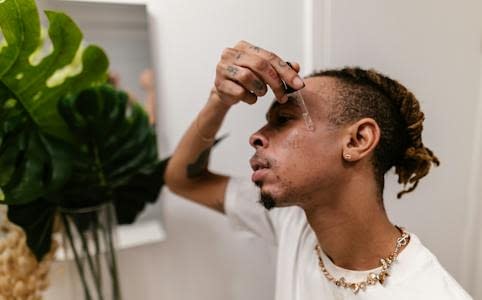
Minoxidil is a medication especially made for hair loss.
During the 1970s, initially, minoxidil was used as an oral medicine to treat high blood pressure. During treatment, doctors observed regrowth in hair that led to its formulation as a topical treatment for hair loss.
To date, topical minoxidil is the mainstay treatment for androgenetic alopecia but used as an off-label treatment for other hair loss conditions like alopecia areata, various types of alopecia, eyebrow, and beard enhancement.
To use minoxidil, you need to apply it directly to the scalp or areas with hair loss to stimulate hair follicles, improve the blood flow of the follicle, prolong the anagen phase of hair, and increase the follicle size.
This process leads to thicker and fuller hair growth.
Minoxidil is present in various strengths, with the most common concentrations being 2% and 5%. Also, there are two forms of minoxidil: foam and solution-based.
Which form of minoxidil is best for beard growth?
As we discussed, minoxidil comes in two forms and strengths, which are 2% and 5% in foam or solution-based forms.
Now, confusion is which form is suitable for you in which concentration. Well, we will discuss the concentration levels in the next segment.
Here, we will know the difference between the forms and which minoxidil is best for beard growth.
The choice between the foam and solution-based minoxidil varies from person to person. According to experts, for treating beards, foam-based minoxidil is better than solution-based.
Liquid vs foam minoxidil:
Here is why you must choose foam-based minoxidil over solution-based:
Sensitivity:
Some people are allergic to certain chemicals and may suffer irritation, redness, and itching in their beards while using minoxidil.
Solution-based minoxidil has chemicals like propylene glycol, which may affect the skin and cause allergic reactions, especially in people with sensitive skin.
Foam-based minoxidil does not contain propylene glycol. However, a person may get affected by other ingredients present in it, but that is rare.
Texture:
The density of the foam-based and solution-based minoxidil is different.
You may feel greasy with solution-based minoxidil, a good option for scalp treatment, as you want it to spread all over the affected area.
But for treating beards, foam-based minoxidil will not make your face greasy, will not drip, and you can apply it all day, even if you are out.
Absorption:
Liquid minoxidil has better absorption capability than foam. Therefore, the chances of it reaching the scalp or facial skin and having dermatitis due to propylene glycol are higher.
Individuals with sensitive skin must choose minoxidil foam to avoid such a situation, as they have few chemicals and rarely harm the skin.
Ease of application:
Minoxidil foam is easy to apply on significant patches like beards, where minoxidil liquids are more suitable for large areas like the scalp.
Since there isn’t enough conclusive evidence regarding which form is more effective, we suggest using the foam to reduce the risk of dermatitis. It appears to be more comfortable and has a less pronounced impact on your appearance.
Is minoxidil 2 or 5 better for a beard?
Studies show that the higher the minoxidil level, the more effective they are. 5% minoxidil works better than 2%. Before opting for 5%, know the whole story.
According to one study, the 393 men diagnosed with androgenetic alopecia were divided into three groups and treated with 2%, 5% minoxidil, and placebo.
After 48 weeks of therapy, the 5% minoxidil group had 45% more hair regrowth than the 2% group. Also, the 5% minoxidil had an earlier response to treatment than other groups.
In this way, we can conclude that 5% minoxidil is far better than 2%. However, the study was based on treating scalp hair regrowth. The results may vary while treating facial hair growth.
Also, you should keep three things in your mind before opting for 5% minoxidil:
- Consult your dermatologist before trying any concentration. They may suggest the concentration suitable for you according to your skin sensitivity, allergies (to some chemicals), and pre-existing medical conditions.
- Higher concentration may lead to faster response, but if you have sensitive skin, start with lower concentration as you may get skin irritation, allergies, or other side effects.
- Consistency is the key. You have to be patient enough to observe any visible result. Observe how your skin reacts, then make the necessary adjustments.
Does minoxidil work for beard growth?
Yes, minoxidil is an effective solution for beard growth. The result may vary from person to person since minoxidil was designed to treat high blood pressure, and its side effect of stimulating hair growth has become an effective solution to treat hair loss.
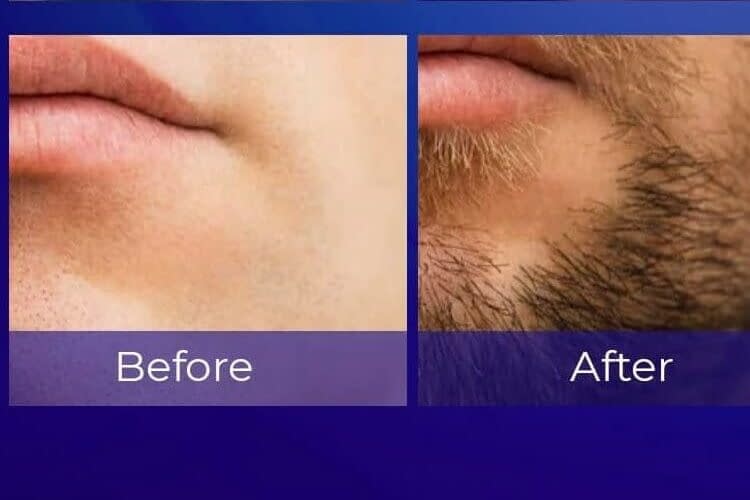
Treating beard patchiness or regrowing a beard is still an off-label usage of minoxidil that needs more research.
Minoxidil is a vasodilator, which means it dilates the blood vessels of the area where we apply it and improves blood circulation, oxygen flow, and nutrition to the hair follicles.
Also, it exponentially increases cell number in hair follicles and rapid tissue growth for thicker and fuller beard growth. However, individual responses to minoxidil can vary, and results may take several months to become noticeable.
Before beginning any minoxidil in your beard care regime, especially for off-label purposes like beard growth, consulting a healthcare professional is crucial, particularly if you have pre-existing medical conditions or concerns.
Though many people are using minoxidil for beard growth treatment, its use for beard growth is still not regulated or approved by health authorities in some regions.
How to choose the best minoxidil for beard growth
To maximize the benefits and reduce potential side effects of minoxidil, selecting the best minoxidil for beard growth requires several aspects.
Here’s a guide to assist you in making a wise choice:
Choose the Right Concentration:
Different concentrations of minoxidil are available; the most prevalent ones are 2% and 5%.
Greater concentrations may cause skin irritation even if they can produce results more quickly. It can be wise to start with a lower concentration if you have sensitive skin.
Consider Formulation:
Minoxidil is available in foam and liquid forms. The decision between the two is a personal taste.
Many people find foam minoxidil more handy and less dirty, but some find applying liquid form more convenient.
As we discussed earlier, if you have sensitive skin, choose the foam version, as it does not contain chemicals like propylene glycol, which can be itchy to your face.
Also, liquid minoxidil is a little greasier than foam.
Look for Extra Ingredients:
Some minoxidils have extra ingredients like biotin to increase their efficacy or reduce side effects.
Look for any components on the product label that might be good for the beard health.
Examine customer feedback:
Look for comments and endorsements from people who have used the minoxidil you are considering buying.
Experiences in the real world can shed light on the efficacy of the product and any possible problems.
Speak with a Medical Professional:
Speak with a healthcare provider before beginning any Minoxidil regimen, particularly for off-label purposes like beard growth.
They can recommend specific to your needs and assistance based on your unique health profile.
Conduct a Patch Test:
Try a patch test on a tiny section of your skin before applying it all over the beard to prevent allergies or reactions.
In particular, this step is mandatory if you have a history of skin sensitivity.
Consider the Side Effects:
While not everyone experiences side effects, but be aware of possible problems, including skin irritation. If you experience any side effects, stop using the product and get medical advice.
Remember, minoxidil may react differently to people, and what works for one person may not work for another. An informed choice, with patience and consistency in application, are essential components of a successful Minoxidil beard growth regimen.
Which minoxidil is best for beard growth?
Here, I will give you both foam-based and solution-based minoxidil choices I have tried in the last few years. You can go with any of the five options. All are safe to improve your beard growth.
Rogaine Men’s 5% Minoxidil Foam for Hair Loss
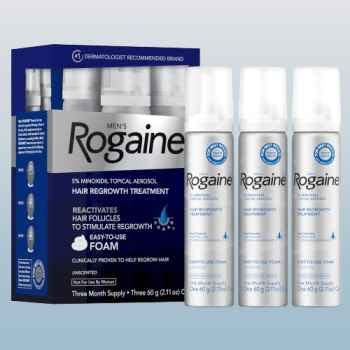
Rogaine minoxidil foam is the most reputable brand that comes to mind when discussing hair regrowth.
The 5% minoxidil foam comes with botanical extracts, AHAs, and humectants, which prevent skin irritation, dryness, and swelling, and by opening the hair follicle, let the minoxidil absorb deeper.
I know minoxidil is an off-label solution for beards, but trust me, I have used it for over five months and visualize the regrowth in my mustache and beards.
Rogaine stimulates hair follicles, extends the hair development phase, and improves blood supply to the follicles.
Over time, this could result in the growth of a fuller, thicker beard, addressing issues with patchiness or sparse facial hair.
The best part of Rogaine 5% minoxidil is foam base. Because the foam can be applied directly onto the skin without irritating, it’s easy to use for applying beards.
Pros
- Clinically proven to regrow beard in 4 months
- It has botanical extracts and emollients to help maintain a healthy skin underneath
- Easy-to-apply foam
Cons
- It may cause skin irritation or itching
- Results may vary depending on the individual
- Quite expensive for long-term use
Follixil Minoxidil 5% Percent for Men and Women
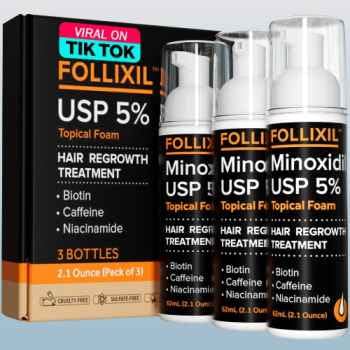
Follixil minoxidil 5% is the most effective yet mild minoxidil for hair regrowth.
The brand develop it with a blend of ingredients like biotin, caffeine, niacinamide, and glycerin to prevent any skin reaction and boost its effectiveness.
The Follixil is a Tictok famous brand for hair regrowth but equally efficiant for beards.
It helps rejuvenate dormant hair follicles and extend the anagen stage while strengthening the hair strands.
One thing you might not like about this is it is slightly oily and has an alcoholic scent, which may disappear after application to some extent.
The greasiness is manageable for the scalp but a matter of discussion for beards.
Pros
- The product is easy to use and comes in an easy-to-use spray bottle.
- Safe and effective formula made with biotin, caffeine, niacinamide, and glycerin.
- It helps keep beard regrowth, treats beard thinning, restores dying hair follicles and improves skin underneath.
Cons
- Requires 3-6 months of constant usage to achieve excellent results.
- Some users may experience itching, redness, and irritation.
- The product may not work for everyone.
Rogaine Men’s Extra Strength 5% Minoxidil Topical Solution
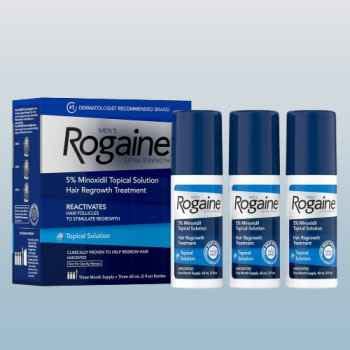
Rogaine 5% minoxidil solution is the most trusted, FDA-approved, and dermatologically tested brand for hair regrowth.
They claim to stimulate 34% of new hair growth after 16 weeks of use, demonstrating their efficacy in treating hair loss and preserving hair density and thick hair growth.
However, their back label suggests preventing using it on any other part of the body, but they are an effective solution for beards.
In contrast to foam, the 5% Rogaine solution is not greasy and absorbs quickly. It is also scent-free. So you won’t notice any overpowering scent beneath your nose.
It is a comprehensive treatment to restore facial hair and filling any spots or thinning hair.
Once more, I strongly advise speaking with a healthcare provider before using it on your face because it may be harmful if you have sensitive skin or are allergic to specific substances.
Pros
- It is clinically proven to enhance hair regrowth by 34% in 4 months.
- Easy to use
- Unscented
- 1st FDA approved brand(safe to use)
Cons
- It can show results after a long time
- It may cause skin irritation or itching
- Expensive
Sunheal 5% Minoxidil Hair Growth Kit for men
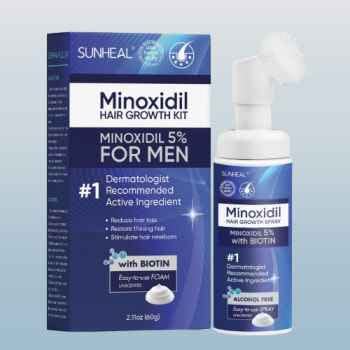
Sunheal 5% minoxidil hair growth foam is a dermatologically tested brand that focuses on strengthening the hair follicle and combating hair thinning and patchiness.
It has the power of biotin, a B-complex vitamin that stimulates hair growth and makes them thicker, fuller, and younger-looking.
The foam-based minoxidil helps to revitalize the hair follicles and repair weak roots and split ends. It comes in an unscented form, which will not suffocate you.
The best part of sunheal minoxidil is it comes with a soft, silicon brush at the top that helps to apply minoxidil hand-free and massage the patch area crucial for hair regrowth.
Sunheal 5% minoxidil promises to give visible results in 8-12 weeks of usage. You may notice new baby hairs, reduced hair loss and thinning.
Pros
- The foam minoxidil is easy to apply
- 5% Minoxidil and Biotin combined promote hair regrowth and enhance strong hair follicles.
- Unscented
- It comes with a silicon brush, easy application and massage
Cons
- Little expensive than other minoxidil
- It may cause dryness or itching on the face
- Results may vary from person to person
5% Minoxidil Hair Growth Serum For Men
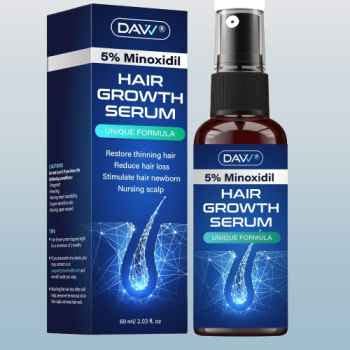
Davv 5% minoxidil hair growth serum is one of the affordable yet effective, dermatologically recommended brands that have proven results in hair regrowth, reducing hair fall, patchiness, and thinning.
The serum contains bio-active ingredients essential for replenishing natural oils, revitalizing hair follicles, and accelerating new hair growth.
The spray-based applicator helps to apply minoxidil to the focussed area without wasting it and provides better absorption.
The serum promises to give results in 4-8 weeks of application by revitalizing hair roots and repairing split ends.
The only thing that might bother you is it feels a little greasier on beards due to the presence of biotin, and you may face initial inactive hair loss as new hair makes room.
Pros
- Promotes new hair growth and restores thicker hair
- The spray design offers precise dosing and less wasteful application.
- Easy to apply
Cons
- Some consumers may find the odor of the serum off-putting.
- It can take longer than the 4–8 weeks for significant results.
- It may cause itching or irritation on the face.
How to use minoxidil for a beard?
Understanding how to apply minoxidil correctly to encourage the facial hair growth is essential to avoid any adverse effects.
Here’s an expert guide on how to use minoxidil for beard growth:
Choose the Right Minoxidil Product:
Purchase a foam or liquid form of minoxidil according to your preference, typically in a concentration of 5% or 2% if you have sensitive skin. Popular brands include Rogaine and Kirkland.
Cleanse Your Face:
Wash your face with a mild cleanser to remove dirt, debris, or oils from your beard. Pat your face dry with a clean towel.
Application:
Use a clean and dry dropper or silicon brush attached to minoxidil bottles or spray to apply the recommended amount of minoxidil (usually about 1 ml) to the patchy areas of your face where you want facial hair growth.
Gently spread the minoxidil over the application area using your fingertips. Massage for a few minutes, or use microneedles for beards to enhance blood circulation and better absorption of that area.
Let it Dry:
Let the minoxidil air dry on your face. It usually takes about 4 hours for it to be fully absorbed.
In accordance with the directions on the product, apply minoxidil once or twice daily. For results, consistency is essential.
Recall that not everyone has the same degree of success with minoxidil for beard growth and that individual results may differ.
Does minoxidil have side effects?
Although minoxidil is usually regarded as safe for quite a few people, adverse effects are possible in certain situations.
Be mindful of the following possible side effects when taking minoxidil to grow your beard:
Skin irritation:
Redness, itching, or irritation at the application site are typical adverse effects. Most of the time, this is moderate and transient, but if it continues, you might have to stop using it.
Dry Skin:
Some people may experience dryness in the area where minoxidil is applied. Using a moisturizer could help to lessen this feeling.
Increased Hair Loss:
During the first several weeks of use, some people may experience hair loss. It is typically transient and indicates the possibility of future hair growth.
Unwanted Hair Growth:
Minoxidil may occasionally induce hair growth in unexpected areas, especially if it comes into contact with nearby skin.
Feeling lightheaded or dizzy:
Systemic absorption of minoxidil is possible, however uncommon, and may result in symptoms such as lightheadedness or dizziness. If you encounter these signs, get help from a physician.
Allergic Reactions:
A minoxidil allergy may cause symptoms like redness, edema, or trouble breathing in some individuals. Immediately seek medical attention if you encounter these symptoms.
Irregularities in heartbeat:
Minoxidil has the uncommon ability to enter the bloodstream and impact the heart. Seek immediate assistance if you suffer from chest pain, an irregular heartbeat, or other cardiovascular problems.
Eye irritation:
Minoxidil might irritate eyes, so keep your distance from them. Rinse your eyes well with water if any of it gets in them.
It’s best to speak with a dermatologist or healthcare professional before beginning a minoxidil regimen, particularly for off-label usage like beard growth.
Conclusion
In conclusion, determining the best minoxidil for beard growth depends on individual preferences and skin sensitivities. Popular options like Rogaine and Kirkland offer 5% concentration and positive results for many users.
However, consulting a healthcare professional before starting any minoxidil regimen to ensure safety and effectiveness tailored to your specific needs.
FAQs:
Is minoxidil’s beard permanent?
No minoxidil beard are not permanent. You might get in the same situation like before if you stop using it. You need to regularily use it in your beard care regime to ensure the best results.
What is the success rate of minoxidil?
The success rate varies from person to person. Some people may observe minoxidil results in 4-6 months, where some have experience no regrowth. So we may conclude 70% success rate of minoxidil.
Can I shave my beard while using minoxidil?
Absolutely, you are able to shave when taking minoxidil. You’re not taking care of your beard externally; instead, you’re concentrating on improving the health of your hair follicles, blood flow, oxygen flow, and nutrition flow—all of which are impaired by shaving.
Does minoxidil affect testosterone?
Minoxidil doesn’t significantly affect testosterone levels when applied topically; systemic absorption is minimal.
What happens if I stop using minoxidil?
Discontinuing minoxidil may lead to gradual hair loss, returning to pre-treatment levels over time.
How long does it take to grow a full beard with minoxidil?
The time to grow a full beard with minoxidil varies, but visible results typically appear within a few weeks to months, with continued improvement over time.
Kayden is an entrepreneur, writer, hairstylist working in a professional salon. He specializes in men’s grooming. He loves to blog about beards, hairstyles, and skincare.